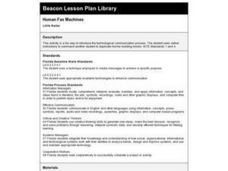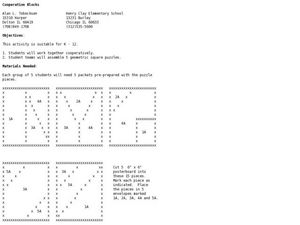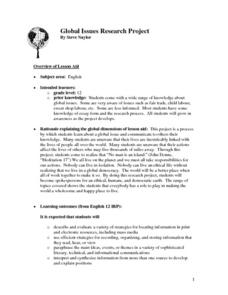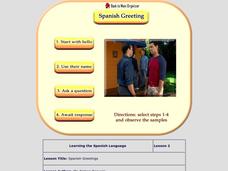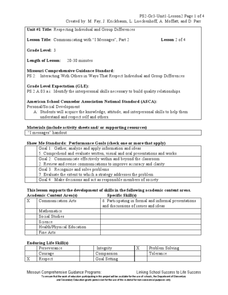Curated OER
Human Fax Machines
Fourth graders discover how to communicate effectively by giving oral directions to make a peanut butter and jelly sandwich. They work with a partner and give oral directions for block building.
Curated OER
COOPERATION BLOCKS
Students follow oral instructions in order to make a pattern with wooden blocks.
Curated OER
Exploring Geometry in the Real World
Students find real-world examples of a variety of geometric shapes. They conduct research, record observations, and write descriptions. They create a classroom cityscape and highlight the information they gathered. They present an oral...
Curated OER
Percents: What's the Use
Middle schoolers research percentages in real world situations. In this percents activity, students demonstrate their ability to apply percents to everyday situations. Middle schoolers communicate mathematically by conducting interviews...
Curated OER
Culture of China
Second graders explore the oral language of the Chinese, retell folk tales, and eat with chopsticks. They view a slide show of China to examine what life is like in China. They memorize three Chineses phrases and note three differences...
Curated OER
A Heritage Study: Using Information Resources to Research Family History and Traditions
Students research their family history through ethnographical study. They locate information through a variety of sources, interview people, write a report and present an oral presentation to the class.
Curated OER
Twisting Versions of Little Red Riding Hood
Students read orally two versions of Little Red Riding Hood (Classic and Cajun) They compare and contrast the two Little Red Riding Hood versions. Students create a concept map to demonstrate the comparisons/contrasts. They could also...
Curated OER
Climate Change
Ninth graders compare the Arctic and Antarctic. In this climate lesson students work in groups, research and complete an oral report or a poster.
Curated OER
Sports and Sir Isaac Newton
Eighth graders choose a sport to observe and capture pictures of Newton's Laws of motion in action within the sport. They import these pictures into Avid Cinema to create a multimedia project to go along with the written report and oral...
Curated OER
Global Issues Research Project
Students examine different global issues and share their learned information with others. Students choose a topic to research, write a research essay, conduct a survey about knowledge and attitude toward chosen topic, and create an oral...
Curated OER
EGG MAZE: COUNTING BY TWOS, THREES AND FIVES
Students successfully count by twos, threes and fives, using pictures of eggs and poultry as points of interest. They orally review the types of counting (twos, threes, or fives). Students are introduced the idea of a dozen eggs.
Curated OER
Inventions Change the World: The Enigma Machine
Third graders explore WWII by analyzing technological advances. In this invention activity, 3rd graders discuss the use of the Enigma machine which decoded private German messages that communicated with U-boats. Students utilize a...
Curated OER
Fluency in Foreign Language Using iMovie
Students communicate more competently in the language they are studying during oral presentation. They translate movies from their language of study to English. They evaluate correct and incorrect pronunciations and conversations.
Curated OER
Social Studies: When Diseases become Epidemic!
Student participate in oral discussions to be able to define epidemic and identify 3 instances in history in which epidemics occurred. They are introduced to the quarter theme, disease. High schoolers identify disease as a crucial...
Curated OER
Lesson 2- Spanish Greeting
Break down a quick conversation in Spanish. After the teacher presents the vocabulary, the class heads to the computer lab, where class members can watch a brief interactive video. The visual is one clip separated into four clearly...
International Debate Education Association
Speaking Across the Curriculum
With the focus on 21st century skills it is even more important that all teachers incorporate listening and speaking activities into their curriculum. Here's a packet of practical ideas appropriate for any classroom.
New York State Education Department
Comprehensive English Examination: June 2016
Those in positions of authority don't always have the best interest of their people in mind. As part of a sample assessment question, readers must consider how works of literature they read apply to a quote from Edmund Burke—"The greater...
Core Knowledge Foundation
Rocks & Minerals
Take young geologists on an exploration of the rock cycle with this six-lesson earth science unit on rocks and minerals. Through a series of discussions, demonstrations, and hands-on investigations your class will learn...
Curated OER
Open Wide and Meet Your Tonsils
Students research their tonsils in this lesson. They research and discover what tonsils are, what they do, and where they are located. Students also identify other parts of the mouth, what they do, and where they're located. They...
Curated OER
A Chick Called Saturday
Students explain what a calendar is all about in terms of time measurement. They clearly communicate in oral, artistic, written and nonverbal forms.
Curated OER
Message Control
Students examine various forms of propaganda and how they are used to manipulate public opinion. Students review the techniques of propaganda, learn to recognize propaganda in oral, written, and visual communications and practice...
Curated OER
Eatem Up!
Students identify, interpret and demonstrate a positive learning attitude. They identify, comprehend and use basic concepts and skills and then, communicate clearly in oral, artistic, written, and nonverbal form. Students also identify...
Curated OER
Act It Out!
An effective way to demonstrate understanding is by synthesizing one's own work. Use a creative lesson designed for a unit on Lorraine Hansberry's A Raisin in the Sun for small groups to show what they know about the play,...
Curated OER
Communicating with "I Messages", Part 2
Third graders listen to ways they share their feelings with others. After brainstorming situations where "I messages" would be appropriate, pairs of students write messages from the lists they developed. They discuss how their messages...


